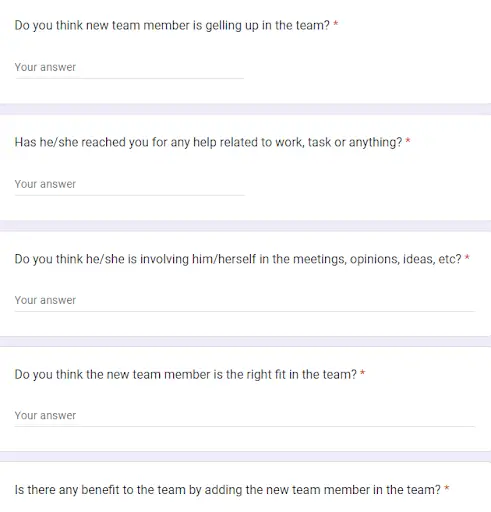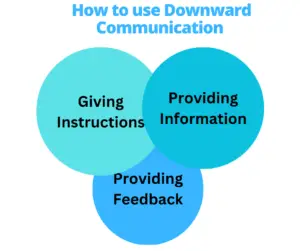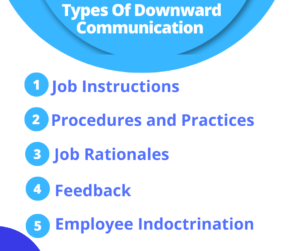In this blog, we have detailed everything you need to know about what is downward communication with examples, objective, types, and how you can improve downward communication.
Definition of downward communication
Downward communication flows from top management to employees. This communication is actually in companies with extremely authoritative style of management (Weihrich, Koontz, 1993)
What is Downward Communication?
Downward communication refers to the flow of information, feedback, and instructions from higher levels of management within an organization to lower levels, such as employees or subordinates. It represents the formal channel through which top-level executives convey their decisions, policies, goals, and other relevant information to those under their supervision.
In this communication direction, the information flows from the top of the organizational hierarchy toward the bottom, following the established chain of command.
For example:
- Team leader updating members of the team about an upcoming deadline.
- Managers inform subordinates about new policies.
- Superior reviewing the monthly performance of a subordinate.
A downward flow of communication can occur through various channels, including meetings, emails, reports, official announcements, and even through the organization’s digital platforms. When executed effectively, downward communication fosters a sense of direction and contributes to overall productivity and success in the workplace.
Characteristics of downward communication:
Downward communication possesses several distinct characteristics that distinguish it from other forms of organizational communication. These characteristics are essential to understand for effective implementation and successful transmission of information within the hierarchy. Here are the key characteristics of downward communication:
- Formal Nature: Downward communication, typically follows formal channels and established protocols within the organization.
- Limited Feedback: Unlike upward communication, where feedback is encouraged, downward communication tends to have limited feedback.
- Control and Direction: Downward communication plays a crucial role in controlling and guiding the organization’s activities.
- Motivation and Recognition: Managers use downward communication to motivate employees by recognizing their efforts, providing positive feedback, and acknowledging their contributions to the organization’s success.
Understanding the following aspect and the nature of downward communication is crucial for the effective implementation and management of this form of communication.
Diagram of downward communication

Main Objectives of Downward Communication
Downward communication flows from higher levels in the hierarchy to achieve the following objectives:
1/ Transmitting Organizational Vision and Mission: One of the primary objectives of downward communication is to convey the overall vision and mission of the organization to all employees. This ensures that everyone understands the long-term goals, values, and purpose of the company. By sharing the organizational vision and mission, employees can align their individual efforts with the broader objectives, fostering a sense of unity and common purpose throughout the organization.
2/ Assigning Tasks and Roles: Effective downward communication involves assigning tasks and roles to employees based on their skills, expertise, and responsibilities. Managers delegate work to their subordinates by clearly communicating what needs to be done, the responsible individuals for every task, along with the deadlines for completion. This helps in optimizing productivity and creating a structured work environment.
3/ Providing Instructions and Guidelines: In any organization, there are specific guidelines, policies, and procedures that need to be followed to maintain consistency and efficiency. Downward communication flow ensures that these instructions and guidelines are effectively communicated to employees. It may involve providing details about how to carry out certain tasks, using specific tools or technologies, or following company policies.
4/ Sharing Important Information and Updates: Effective communication ensures that employees are well-informed about critical updates, changes, and developments within the organization. Downward communication plays a vital role in sharing important information such as company announcements, project updates, policy changes, and other relevant news.
5/ Delivering Performance Feedback and Evaluation: Feedback is crucial for employee development and performance improvement. Downward communication facilitates the delivery of performance feedback from managers to their subordinates. Managers can provide constructive feedback on employees’ strengths, areas for improvement, and overall performance.
Example of downward communication in an organization
Downward communication in business communication not only involves conveying crucial information to lower-level employees but also includes seeking important information from them. For instance, managers may ask employees to provide feedback on various aspects of the organization’s function.
An example of this can be seen in the email below, where employees are instructed to provide feedback on the new joiners within the team.


Superior used downward communication to inform crucial information, but in a practical scenario how it is done is demonstrated in the below example.
After AT & T acquired BellSouth and Cingular Wireless, Ed Whitacre, then CEO of AT & T used downward communication to inform the former BellSouth and Cingular employees about the company acquisition strategy. Whiteacre held meetings to assure employees that he understood the changes resulting from the acquisition caused turmoil and confusion in the short term and asked them to continually provide excellent customer service during the transnational period. The face-to-face meeting gave employees the opportunity to ask questions.
Source” Erik S. Lesser/ The New York Times
How does downward communication work?
The downward communication process is vital for sharing organizational goals, providing instructions and important information. Here’s how downward communication works:
1/ Initiation: Downward communication typically starts at the highest levels of the organization, such as the executive team or top management. It begins with the formulation of key messages or information that needs to be communicated to employees at lower levels. This information may include strategic objectives, organizational changes, performance expectations, or specific task assignments.
2/ Message Encoding: Once the information is determined, the senders (e.g., managers or leaders) encode the messages into a suitable format. The format may vary depending on the complexity and nature of the information. It could be written documents, emails, memos, presentations, videos, or other forms of communication.
3/ Selection of Communication Channels: Choosing the appropriate communication channels is essential for effective downward communication. Common channels include face-to-face meetings, town hall sessions, emails, intranet portals, internal social media platforms, and other digital collaboration tools. The choice of media for a downward communication channel depends on factors such as the urgency of the message, the size of the audience, and the level of interaction required.
4/ Transmission: After encoding the message and selecting the communication channel, the senders transmit the information to the intended recipients (lower-level employees). In some cases, the message may flow through various levels of management before reaching its final destination. This multi-level transmission process can lead to potential filtering of the message.
5/ Reception and Decoding: The recipients (employees) receive the downward communication messages through the chosen channels. They then decode and interpret the message to understand its content and implications. Understanding the message correctly is crucial to ensure that employees act on the information appropriately.
6/ Feedback and Clarification: In an ideal business communication process, downward communication includes opportunities for feedback and clarification. Employees should feel encouraged to ask questions, seek clarification, and provide feedback on the information received. This two-way communication fosters a sense of openness and engagement within the organization.
7/ Implementation: The recipients of downward communication take action based on the information received. This may involve executing tasks, aligning their work with organizational objectives, or making necessary changes based on policy updates or feedback.
8/ Monitoring and Evaluation: After the message has been delivered and acted upon, management may monitor the outcomes and evaluate the effectiveness of the communication process. This evaluation helps identify any communication gaps, challenges, or improvements needed for future downward communication efforts.
Elements of Downward Communication
The elements of downward communication are the key components that make the communication process effective and successful. These elements include
- Sender: The sender is the initiator of the downward communication process. It could be a manager, supervisor, leader, or any individual at a higher level of the organizational hierarchy who has information or a message to convey to subordinates.
- Message: The message is the information or content that the sender wants to communicate to the recipients (lower-level employees). It can be in various formats, such as verbal instructions, written memos, emails, presentations, or any other form of communication.
- Channel: The channel refers to the means or medium used by the sender to transmit the message to the recipients. Common communication mediums include face-to-face meetings, emails, verbal interactions, town halls, digital collaboration tools, and more.
- Receiver: The receiver refers to the recipients of the downward communication. It comprises the employees or subordinates at lower levels of the organizational hierarchy who receive and interpret the message.
These elements work together to facilitate the flow of information from top to bottom in the organizational structure.
Usage of Downward Communication in an Organization
The usage of downward communication in an organization refers to the intentional and strategic flow of information from higher levels of management to lower-level employees. It serves several crucial purposes:

1/ Providing Instructions and Task Assignments: Managers use downward communication to delegate tasks, assign responsibilities, and provide clear instructions on how to carry out specific duties effectively.
2/ Delivering Performance Feedback: Supervisors and managers use a downward channel of communication to provide feedback on employees’ performance. This can include appreciation for achievements and constructive feedback to support employees in enhancing their performance.
3/ Managing Change: During times of organizational change, downward communication plays a critical role in explaining the reasons behind the change, managing potential resistance, and helping employees adapt to new circumstances.
4/ Enhancing Decision-Making: Downward communication allows information to flow from various departments to decision-makers, assisting in informed and well-rounded decision-making processes.
Overall, the proper usage of downward communication in the workplace ensures that important messages are delivered clearly, consistently, and in a way that fosters understanding and collaboration among all employees.
Purpose of downward communication in an organization
The purpose of downward communication is to convey information from higher levels of the organizational hierarchy to lower levels. It aims to circulate organizational goals, provide guidance, delegate tasks, and manage change. Effective downward information flow ensures that employees are well-informed, aligned with the organization’s objectives, and equipped to carry out their roles successfully. It fosters transparency and collaboration, contributing to overall organizational performance and success.
Methods of downward communication
Downward communication in the workplace is facilitated through either oral or written methods. depending on various factors, including the urgency and significance of the message.
Oral communication is the most commonly used form of downward communication. It allows superiors to directly communicate with their subordinates, facilitating the transfer of crucial information. The oral communication method is also time-efficient, ensuring that messages are delivered quickly. Additionally, during delegation, oral communication helps minimize misunderstandings between superiors and subordinates.
Must Read:
Another method used for downward communication in business is written communication, which includes memos, short reports, notices, circulars, and business reports.
Written messages are typically more detailed and carry crucial organizational information that requires immediate action from subordinates. Additionally, written communication is considered more authentic and can be referred to over a longer period by the team. Apart from the methods mentioned above, downward communication can also be transmitted through various other channels, including digital media and print media.
Must Read: What are the benefits and limitations of written communication method
What is the Importance of Downward Communication in a Merger?
During a merger, downward communication plays a pivotal role in managing uncertainty and anxiety among employees. Mergers introduce significant changes that can lead to concerns about job security and the future direction of the organization.
Through clear and transparent communication, downward communication addresses these worries by providing essential information about the merger’s objectives, timeline, and impact on employees. Additionally, it helps align employees with the merged entity’s new shared vision and strategic goals, ensuring a unified sense of purpose and direction.
Furthermore, in the context of cultural integration, where merged organizations may have different work styles and practices, top-down communication fosters openness and understanding among employees from both entities, creating a cooperative work environment.
Building trust and engagement is crucial during a merger, and effective downward communication helps achieve this. By valuing employee input and addressing their concerns openly, the communication process strengthens the bond between employees and the organization.
Moreover, downward communication is essential in addressing employee retention concerns. Mergers may give rise to fears of layoffs or job instability. By reassuring employees about their future prospects within the merged organization, downward communication contributes to retaining valuable talent.
Overall, downward communication plays a critical role in a merger. Its strategic implementation ensures a smoother integration process, leading to a successful merger and setting the stage for a strong and unified organization in the long run.
What is Vertical Downward Communication?
Vertical downward communication refers to the flow of messages from leaders at the top levels to employees at the lower levels. It is an essential tool for ensuring that employees are well-informed, aligned with the organization’s objectives, and equipped to contribute to the overall success of the organization. Vertical downward communication helps create a cohesive and informed workforce and fosters transparency and accountability within the organization’s hierarchical structure.
Related Reading: What is Vertical Communication: Examples, Types & Importance
What is Internal Downward Communication?
Internal downward communication is a specific direction of communication within an organization. It refers to the transmission of information from supervisors to employees or team members.
Internal Downward Communication serves several essential functions within an organization such as:
- Motivation and Inspiration:
- Alignment with Organizational Goals:
- Conflict Resolution:
- Employee Development:
- Organizational Culture Reinforcement:
Various methods are used for internal downward communication, including face-to-face meetings, staff memos, emails, bulletin boards, and other internal communication tools.
To ensure effective internal downward communication, it is crucial for leaders and managers to be clear, concise, and consistent in their messages. They should encourage open dialogue, actively listen to employee feedback, and make an effort to be approachable, as it will help cultivate an atmosphere of trust and transparency within the organization.
Types of Downward Communication
Downward communication can be categorized into five distinct categories. They are:

1) Job Instructions: Job instructions are a type of downward communication where managers or supervisors provide specific guidance and directions to employees on how to perform their tasks and responsibilities effectively. These instructions aim to clarify what needs to be done, how it should be done, and any essential guidelines or standards that employees should follow. Clear job instructions are crucial for ensuring employees understand their roles and responsibilities and can carry out their tasks efficiently.
2) Job Rationales: Job rationales involve explaining the reasons behind certain decisions, policies, or assignments given to employees. Managers use this form of communication to provide context and justification for tasks, decisions, or changes, which helps employees understand the broader organizational objectives and how their roles contribute to them. By sharing the reasoning behind instructions, employers can boost employee engagement and commitment, fostering a greater sense of motivation among their workforce.
3) Procedures and Practices: Downward communication related to procedures and practices involves conveying step-by-step guidelines, rules, and best practices to employees for various organizational processes. These procedures may cover anything from safety protocols to how to handle customer inquiries or how to use specific software tools. Effective communication of procedures and practices ensures uniformity in work processes and minimizes errors and inefficiencies.
4) Feedback: Feedback is a critical aspect of downward communication, where managers provide constructive comments, evaluations, and assessments of employee performance. This feedback can be both positive, acknowledging good work and achievements, as well as developmental, addressing areas that need improvement. Regular and timely feedback in communication helps employees understand how they are doing, align their efforts with organizational goals, and continuously improve their skills and performance.
What is Downward feedback with an example?
Downward feedback is an opportunity for managers to provide feedback to their subordinates on issues related to their work environment, performance expectations, or leadership practices.
For example, for providing enough guidance to employees on how to complete tasks effectively. Managers schedule meetings with teams and discuss their concerns and provide feedback accordingly.
5) Employee Indoctrination: Employee indoctrination also referred to as onboarding or orientation, is the formal process by which new employees are introduced to the organization’s culture, values, and mission. During this type of downward communication, new employees receive information about the company’s history, policies, expectations, and specific roles within the organization. Effective indoctrination helps new hires adapt to the company culture faster and become productive team members more quickly.
Forms of Downward Communication
There are different forms of downward communication that organizations commonly use to convey information within the organizational hierarchy. These forms of downward communication include:
1/ Face-to-Face Communication: This is the most direct and personal form of downward communication. It occurs in meetings, one-on-one discussions, town hall sessions, and other interactive settings. Face-to-face communication allows for immediate feedback, clarification of doubts, and the opportunity for employees to ask questions directly.
2/ Written Communication: Written forms of downward communication include emails, memos, official letters, reports, and policy documents. These written messages provide a clear and formal way to communicate important information, instructions, and announcements to a large number of employees simultaneously.
3/ Company Newsletters and Magazines: Organizations often publish newsletters or magazines that contain updates on company activities, achievements, upcoming events, and other relevant information. The purpose of these publications is to ensure employees are well-informed and actively involved in the events and developments within the organization.
4/ Visual Communication: Visual aids like charts, graphs, videos, and presentations are used to supplement other forms of downward formal communication. They help convey complex information more effectively and are particularly useful when communicating data and statistics.
Related Reading: What is visual communication with examples
What are the Barriers to Downward Communication?
Despite the importance of communicating goals and feedback, downward communication can face various barriers that hamper its effectiveness. Understanding these barriers is crucial for organizations to improve their communication strategies and ensure that messages are delivered and understood as intended. The common barriers to downward communication include:
1/ Filtering and Distortion: At the top levels of the organization, managers may filter information before passing it down to lower-level employees. They might withhold sensitive or negative information to avoid causing panic among employees. Additionally, as the information travels down the chain of command, it can undergo unintentional alteration due to misinterpretation, altering the original message by the time it reaches its recipients.
2/ Hierarchical Constraints: Organizational hierarchies can create psychological barriers to downward communication. Lower-level employees may feel hesitant to express their ideas, concerns, or feedback to higher-ups due to a perceived power distance. This can restrain open communication and slow down the flow of valuable information from the bottom to the top of the organization.
3/ Lack of Feedback: Steps of effective downward communication should be a two-way process, where feedback is encouraged and valued. However, if there is a lack of mechanisms for employees to provide feedback or if their feedback is ignored or not acted upon, it can discourage open communication. Employees may become disengaged and less likely to participate in future communication efforts.
4/ Non-Transparent Communication Culture: Organizations that lack a culture of open and transparent communication can face downward communication barriers. When management withholds information or fails to communicate openly with employees, it can lead to reduced trust and engagement among the workforce.
5/ Perception and Stereotypes: Perceptions and stereotypes can affect how downward communication is received and interpreted. If employees have negative perceptions of their superiors or the organization, they may be less receptive to messages from higher-ups. Stereotypes can lead to assumptions about the sender’s intentions or biases, resulting in resistance or mistrust.
Related Reading: What are perceptual barriers in communication
How to Improve Downward Communication?
Improving downward communication within an organization can lead to increased employee satisfaction and better alignment with organizational goals. Here are some strategies to enhance downward communication:
1/ Open and Transparent Communication Culture:
Creating an open and transparent communication culture is a vital technique for improving downward communication. This includes fostering a work environment where employees feel at ease expressing their ideas, concerns, and feedback without any fear of negative consequences. When communication flows freely and openly, it nurtures trust between management and employees, resulting in enhanced engagement and improved collaboration.
2/ Tailoring Communication to Different Audiences:
Not all employees have the same roles, responsibilities, or levels of expertise. Customizing communication for different audiences ensures that the message remains relevant and easily understandable to everyone involved. Managers should consider the recipients’ backgrounds, job functions, and knowledge levels while conveying information. Using clear language and avoiding jargon also enhances the effectiveness of downward communication.
3/ Using Various Communication Channels:
Utilizing a diverse range of communication channels improves the reach and impact of downward communication. Different employees may prefer different methods of receiving information. Employ a mix of channels such as emails, team meetings, video conferencing, bulletin boards, and even social collaboration tools to spread information effectively.
4/ Encouraging Two-Way Communication:
Downward communication should not be a one-way street. Promoting two-way communication involves establishing channels for employees to offer feedback, ask questions, and express their thoughts to the management. This can be achieved through regular check-ins, feedback sessions, suggestion boxes, or open-door policies. When employees feel acknowledged and appreciated, their engagement and commitment to the organization’s objectives are more likely to increase.
5/ Regularly Seeking Employee Feedback:
Actively seeking feedback from employees about the effectiveness of downward communication is essential. Surveys, suggestion boxes, or regular feedback sessions can help gather insights on how well information is being conveyed, whether it is understood, and if there are any areas for improvement. Addressing feedback demonstrates that the organization values employee opinions and is committed to improvement.
6/ Emphasizing the Importance of Active Listening:
Active listening plays a crucial role in facilitating effective communication. Managers should practice active listening when engaging with their teams, demonstrating genuine interest in what employees have to say. Actively listening to employees’ concerns and ideas helps build rapport and trust, and it enables managers to respond appropriately and address issues effectively.
Implementing these best practices can significantly improve the effectiveness of downward communication in an organization. Effective downward communication leads to better understanding, increased employee engagement, and alignment with organizational goals, ultimately, fostering a productive and cooperative work environment.
Advantages & Disadvantages of Downward Communication
In this section, we will look at the benefits and limitations of downward communication.
Advantages of downward communication
Downward communication and its essentials provide the following benefits to a company:
- Maintaining hierarchy: Downward communication works on clearly defined reporting relationships between superiors and subordinates which helps in maintaining a strict organizational chain of command.
- Instructions and directives: The management uses downward communication to direct objectives, provide important information and assign duties and instructions to subordinates.
- Disciplined work environment: Downward communication helps in creating a disinclined and company-oriented workspace by creating a system that emphasizes more focus on work productivity from subordinates.
Disadvantages of downward communication
The disadvantages of downward communication are highlighted as follows:
- Distortion: It is possible for a message to be distorted and lose accuracy as it travels down from one level of management to a lower level.
- Employee resistance: The authoritative nature of downward communication can make subordinates resentful towards superiors and doubt their decisions.
- The issue for under-and-over communication: Downward communication can lead to the transmission of under and over-communication of information due to interference of superiors at different levels of the organization.
To know more check out our detailed guide on: Benefits and limitations of downward communication.
Downward Vs Upward Communication
Aspect | Downward Communication | Upward Communication |
Direction | Flows from higher-level authorities to lower-level employees. | Flows from lower-level employees to higher-level authorities. |
Purpose | To provide instructions, guidance, feedback, and information to employees. | To gather feedback, suggestions, ideas, and reports from employees. |
Information Flow | Top-down dissemination of information and directives. | Bottom-up transmission of feedback and information. |
Control and Decision-Making | Often used for conveying decisions made by management. | Often used to influence decision-making by providing insights and perspectives from employees. |
Formality | Tends to be more formal, following established channels and procedures. | Can be formal or informal, allowing for open communication and sharing of ideas. |
Employee Involvement | Limited scope for employees to initiate communication. | A vertical communication system encourages active participation and involvement of employees in organizational matters. |
Information | Conveys feedback, suggestions, and grievances from employees, providing the benefits of upward communication. | Disseminates policies, instructions, and organizational updates. |
To know more check out our detailed our on: Differences between downward and upward communication
Frequently Asked Questions
Q1) What is downward communication and its example?
Ans: Downward communication also known as “top-down communication” or “superior-subordinate communication, is a form of organizational communication that flows from higher levels of authority to lower levels within a hierarchical structure. An example of downward communication would be a manager in a company holding a staff meeting to inform employees about upcoming changes in company policies and procedures.
Q2) What are the 5 types of downward communication?
Ans: The 5 types of downward communication include. These different types of downward communication ensure that information flows efficiently from top management to the rest of the organization.
Q3) When is downward communication most likely to occur?
Ans: Downward communication occurs when managers or leaders convey information, and guidance to employees. It commonly happens in policy announcements, task assignments, goal setting, and introducing new projects.
Q4) what type of organizational communication flows from a higher level to a lower level, such as a manager communicating with subordinates?
Ans: The type of organizational communication that flows from a higher level to a lower level, such as a manager communicating with subordinates, is known as downward communication.
Q5) What is horizontal communication?
Ans: Horizontal communication, also known as lateral communication, occurs when employees at the same rank or level in the organization communicate with each other. Horizontal channels of communication are mostly oral and informal.
Q6) Purpose of downward communication?
Ans: Downward communication is used by superiors for the purpose of conveying important information about company policies and procedures, training, feedback, giving instructions, advice, etc.
Q7) What is the difference between diagonal communication and downward communication?
Ans: Diagonal communication or crosswise communication is an unstructured form of business communication that can occur between both managers and employees of two different departments, whereas downward communication follows a strict chain of command where communication flows from higher to lower levels of the organization.
Q8) What are the functions of downward communication?
Ans: Downward communication in organizations serves essential functions such as assigning tasks, reinforcing culture, managing change, ensuring safety, offering training opportunities, creating direction, and setting performance expectations. It promotes coordination, and productivity within the workforce.



